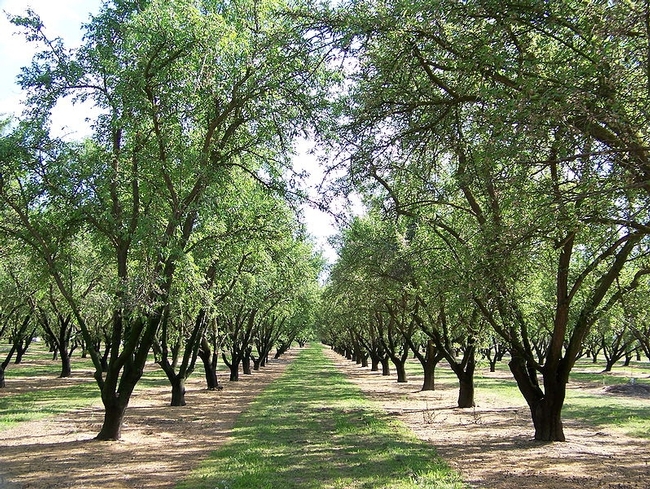Posts Tagged: Blake Sanden
Internet start-up gleans trust from association with UCCE
Ceres Imaging, an Oakland-based start-up, is working closely with UC Cooperative Extension on its aerial imaging of farm fields, a fact that is helping the company gain trust by association, reported Emma Foehringer Merchant on Grist.org.
Ceres puts equipment on low-flying airplanes to take pictures that will help farmers optimize water and fertilizer application. According to field tests, the imagery works. Since 2014, Ceres has teamed up with UC Cooperative Extension to conduct field trials, including one for the Almond Board that measured the response of nuts to different rates of watering.
In that study, data from Ceres' imaging matched well with the UCCE ground "truthing," said Blake Sanden, UC Cooperative Extension water and soils farm advisor.
According to the article, "Ceres' relationship with the extension program has helped the company gain trust with sometimes-skeptical farmers." Sanden called UCCE trials the "gold standard of efficacy" for new products in the ag market.
There is also increased interest in precise water management after years of drought and cutbacks on federal water allocation.
"The attitude (among farmers) used to be, 'I can find water,'" Sanden said. "I would say that 30, 40 years ago, there was an attitude of hope ... that some of the restrictions on pumping water (would) go away." He said growers expected decision-makers "to come back to reality and understand that we've got to make money in California and grow food."
But the restrictions didn't go away. Instead, they became stricter. The uncertainty about water deliveries has made farmers friendlier to new technologies, like the one offered by Ceres.
UC ANR expert provides ag angle on student talk show
The myriad concerns related to California's fourth year of drought were raised during a California State University, Northridge, student talk show that featured a UC Agriculture and Natural Resources (UC ANR) farming expert.
UC ANR Cooperative Extension advisor Blake Sanden was joined on the show, titled On Point, by CSUN sustainability professor Helen Cox and geography professor Amalie Orme. Sanden spoke to the issues related to the agriculture industry. He noted that well-known San Joaquin Valley farmer and rancher John Harris, who manages 7,000 acres of land, is fallowing more than half of it this year and using all the water he has available to irrigate tree crops planted on 2,800 acres.
Asked whether he felt agriculture played a role contributing to the drought, Sanden explained that farmers consider a complete water budget when planning crops and are cognizant of the drought situation in low-precipitation years. He acknowledged that there are human-caused issues related to the drought, noting that the state has placed a priority on environmental preservation, which also requires a great deal of water.
Sanden commented on the now commonly shared fact that it takes a gallon of water to produce a single almond. Indeed, he said, it takes 50 gallons to grow one orange and as much as 100 gallons to produce a glass of milk from cows fed irrigated alfalfa.
"I hear these things going on and sometimes I just have to shake my head," he said. "Somebody is looking for a story with the gallon-per-nut catch phrase and they're not looking at the larger picture."
Recycled irrigation water raises food safety questions
"Everyone smells the petrochemicals in the irrigation water," said Blake Sanden, UC Agriculture and Natural Resources Cooperative Extension advisor in Kern County. "When I talk to growers, and they smell the oil field crap in that water, they assume the soil is taking care of this."
The farmers trust that organisms in the soil remove toxins or impurities in the water. However, the trust may be misplaced.
Microoganisms in soils can consume and process some impurities, Sanden said, but it's not clear whether oil field waste is making its way into the roots or leaves of irrigated plants, and then into the food chain.
It's unlikely that petrochemicals will show up in an almond, for example, he said, "But can they make it into the flesh of an orange or grape? It's possible. A lot of this stuff has not been studied in a field setting or for commercial food uptake."
The reporter also spoke to Carl Winter, a UC ANR Cooperative Extension specialist based at UC Davis. He said some plants can absorb toxins without transferring them to the leaves or the flesh of their fruit.
Still, he said, "it's difficult to say anything for sure because we don't know what chemicals are in the water."
A visiting scholar at UC Berkeley who is a researcher analyzing hydraulic fracturing for the California legislature said the issue is "one of the things that keeps me up at night."
"You can't find what you don't look for," he said.
Farmers dealing with unwelcome 'snow'
Due to the lingering drought, farms in the San Joaquin Valley are being found with an unwelcome white dusting of "snow" on the soil surface. It isn't the snow so desperately needed in California's high country; rather it is salt and other toxins that have precipitated out of the soil because of sparse winter rains, reported Dennis Pollock in Western Farm Press.
At the recent California Plant and Soil Conference in Fresno, multiple speakers showed pictures of what they labeled "California snow," the article said.
Plant toxins like selenium, boron and salt leach out with water, but water is in short supply this year. "That's why a lot of land is fallow," said Gary Banuelos, USDA-ARS researcher in Parlier.
At the conference, Rick Snyder, UC Cooperative Extension specialist in the Department of Land, Air and Water Resources at UC Davis, said applying less water will reduce deep percolation and could result in higher salinity in the rooting zone. Eventually deficit irrigation will become problematic, especially if practiced over a longterm drought.
Snyder said it might be better to apply available water to a smaller area to maintain production. In the case of permanent crops, he suggested the same frequency of irrigation, but using less water with each application.
David Doll, UCCE farm advisor in Merced County, said almonds are sensitive to high levels of sodium, chloride and boron; and that some rootstocks are more tolerant of saline conditions than others.
Dan Putnam, UCCE specialist in the Department of Plant Sciences at UC Davis, said alfalfa may be capable of tolerating higher salt levels than previously thought.
Some degraded water that could not be used on food crops can be used on alfalfa, he said, adding that alfalfa is in higher demand than many other salt-tolerant plants. While salinity may trigger a decline in percentage of germinated seeds, Putnam said, “that doesn't scare us; we can live with a 40 percent level.”
Blake Sanden, UCCE advisor in Kern County, said there are research gaps with regard to soil toxin tolerance in pistachios.
However, he said, a buildup of boron in the soil is "a potential boron time bomb."
Sanden's research showed a doubling of total boron in the soil after nine years. Without 6 to 10 inches of rainfall or fresh water winter irrigation for leaching every one to two years, he said, high levels of boron could render pistachio production unsustainable.
Almonds become California's second-most valuable commodity
When California publishes its crop report in November, there will be a significant change in the ranking order of the state’s top agricultural commodities. In 2011, for the first time ever, the value of the California almond crop surpassed the state’s iconic grape industry to move into second place, behind dairy.
California almonds are on a roll. In the last 20 years, scientific discovery and grower ingenuity have nearly doubled almond per-acre productivity. A good yield in the 1980s was 1,400 pounds per acre. The average yield for 2011 was 2,670 pounds of shelled almonds per acre.
Forty years ago, California farmers produced less than 100 million pounds of almonds on about 200,000 acres of almond orchards. Mechanization, improved irrigation efficiency, advances in insect and disease management, pruning research and fertilization studies have fueled explosive growth in the industry. Farmers in California’s Central Valley now tend 760,000 acres of almond trees, producing about 2 billion pounds of shelled nuts a year. The crop, which represents 100 percent of U.S. almond production and 75 to 80 percent of world production, was valued in 2011 at $3.87 billion, surpassing table, wine and raisin grapes, which were valued at $3.86 billion.
“Even with this record production, we have more demand than we have supply,” said Bob Curtis of the Almond Board. “The driver behind that is nutrition studies that show almonds are a healthy food and snack.”
A tremendous amount of UC research is behind the California almond success story, said Bruce Lampinen, UC Cooperative Extension specialist in the Department of Plant Sciences at UC Davis, an expert in almond canopy management.
“Higher density plantings of almonds and a trend towards less pruning, and improved water management have led to much higher yields,” Lampinen said.
Many almond growers have replaced flood irrigation with micro-sprinkler or drip irrigation, said Larry Schwankl, UC Cooperative Extension specialist in the Department of Land, Air and Water Resources at UC Davis. These irrigation systems increase the precision of water and fertilizer application. Over the years, UC Cooperative Extension advisors and specialists established demonstrations of micro-sprinkler and drip systems in many parts of the Central Valley and reached out to farmers to show how they could be managed to optimize production.
“Twenty years ago, we simply guessed at the amount of water that the trees needed and we applied it on a calendar basis,” said Joe MacIlvaine, president of Paramount Farming Company in Kern County, one of the state’s largest growers of almonds, pistachios and pomegranates. “Today, we are delivering water and nutrients directly to the root zones when they are needed.”
Two decades ago, a granular form of nitrogen fertilizer was generally applied to almond orchards in the fall to allow winter rain and irrigation to move it into the soil for use by the trees in spring and early summer. Nitrogen use efficiency was believed to be about 40 percent. Now, nitrogen fertilizer is applied through the irrigation system during the growing season, when the tree needs it.
“Today, our nitrogen use efficiency can be as high as 85 percent,” said Blake Sanden, UCCE advisor in Kern County, an irrigation expert. He and Patrick Brown, professor in the Department of Plant Sciences at UC Davis, have conducted nitrogen trials in almonds with Paramount Farming.
“When you increase the conversion of applied nitrogen fertilizer to higher crop yield, there is significantly less potential for nitrogen to leach below the rootzone and contaminate groundwater,” Sanden said. “But each field is unique and requires site-specific management to achieve these high levels of efficiency.”
Another area where UC research has led to significant crop yield growth is in canopy management and tree spacing. Research by Mario Viveros, UCCE advisor emeritus in Kern County, and other scientists showed that a tendency among growers to over prune was taking a toll at harvest time.
“A lot of farmers who are now growing almonds had experience with fresh fruits, where you do need to prune to get light on the fruit for good color. In almonds more canopy generally means more yield,” Lampinen said. “Today, most almond growers only prune when branches are growing in the way of tractors or other equipment.”
UC research also found that orchards planted with traditional wide spacing between the trees weren’t making the most efficient use of sunlight on the farms. Older orchards had 60 to 70 trees per acre. Today, almond orchards are planted at an average density of about 110 trees per acre based on results of UC research.
However, studies have also shown that crowding still more trees into orchards triggers diminishing returns. In almond production, the nuts are shaken from the trees to dry on the ground before they are harvested.
“If the orchard floor becomes too shaded by trees planted too densely, the orchard floor temperature and humidity become optimal for growth of pathogens that could become a food safety problem,” Lampinen said. “You want enough sunlight to hit the orchard floor to reduce potential pathogens, like salmonella.”
MacIlvaine acknowledged the role of UC Cooperative Extension in helping the almond industry achieve the production milestone in 2011.
“The University of California has been a wonderful partner in improving our farming practices,” he said. “The whole system is not only more efficient, but more sustainable at the same time.”
Hear more of MacIlvaine's comments in the video posted below:






